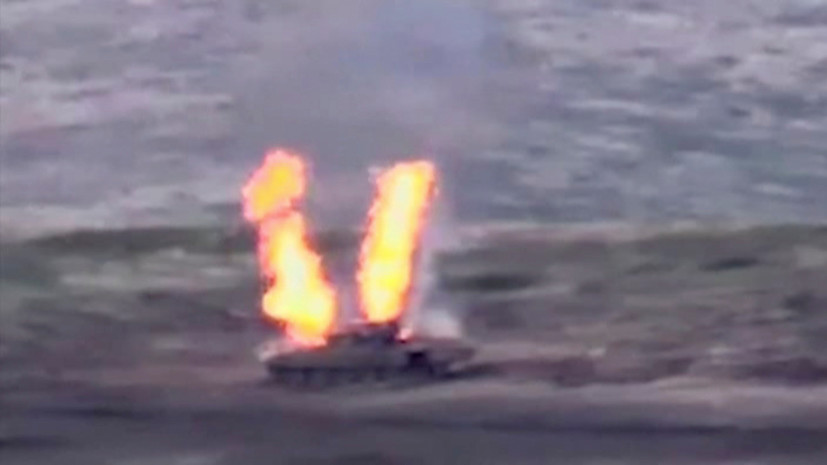Fighting resumed between Armenia and Azerbaijan.
On the morning of September 27, the Azerbaijani Defense Ministry reported that the Armenian Armed Forces fired from mortars and large-caliber weapons at the settlements on the contact line in Karabakh.
Later, the press secretary of the president of the unrecognized Nagorno-Karabakh Republic, Vahram Poghosyan, stated that the city of Stepanakert had been shelled.
“All border settlements, as well as the capital Stepanakert, are under fire.
All civilian objects are at gunpoint.
The shelling is conducted from the Grad systems, - Interfax quotes Poghosyan as saying.
According to the office of the Human Rights Defender of the Nagorno-Karabakh Republic, as a result of the shelling, there are civilian casualties: at least two people were killed, more than 50 were injured.
The Azerbaijani Defense Ministry claims that it is taking "retaliatory measures" after the Armenian Armed Forces fired at settlements on the contact line in Karabakh.
Yerevan, in turn, accused Baku of "beginning an offensive" in the direction of Karabakh.
Against the background of the current situation, martial law was introduced in Armenia and a general mobilization of the reserve was announced.
Prime Minister Nikol Pashinyan stated this.
“Dear compatriots, now, by the decision of the government, martial law and general mobilization are declared in Armenia.
To all personnel: I urge them to report to the military commissariats, ”he wrote on Facebook.
After the announcement of a general mobilization in Armenia, the first volunteers gather in the Republic Square in Yerevan
In addition, Yerevan claims that Azerbaijan also fired on the territory of Armenia.
This statement was made by the representative of the Armenian Ministry of Defense of Armenia Artsrun Hovhannisyan.
"During the missile and artillery operations against Artsakh (self-name of Karabakh. -
RT
), strikes were also struck in the direction of Vardenis (a city in Armenia near the border with Azeibaydjan. -
RT
)," RIA Novosti quotes Hovhannisyan.
Pashinyan later addressed the nation in connection with the situation in Nagorno-Karabakh.
According to him, "the authoritarian regime of (Azerbaijani President Ilham. -
RT
) Aliyev" has declared war on the Armenian people.
The Prime Minister of Armenia also called on the international community to pay attention to the situation, since it "can have irreversible consequences, go beyond the borders of the region and threaten international peace and stability."
Azerbaijani President Ilham Aliyev, in turn, addressed the Azerbaijani nation.
He accused Yerevan of committing "another military provocation" and noted that Baku only "protects territorial integrity."
In addition, Aliyev said that "the occupation of Azerbaijani lands is part of Armenia's plans," and by aggravating the situation in Nagorno-Karabakh, Yerevan is trying to "divert the attention of the country's population from very serious social and economic problems."
International reaction
The Russian Foreign Ministry called on the parties to the conflict to stop hostilities and start a dialogue.
"We call on the parties to immediately cease fire and start negotiations in order to stabilize the situation," the Russian Foreign Ministry said in a statement.
The ministry also indicated that "along the line of contact from both sides there are intense shelling."
In addition, losses are reported.
In this regard, Russian Foreign Minister Sergei Lavrov held several telephone conversations with the heads of foreign diplomatic departments.
The Russian Foreign Minister spoke with his Armenian counterpart Zohrab Mnatsakanyan, as well as with Azerbaijani Foreign Minister Jeyhun Bayramov.
According to a commentary posted on the Russian Foreign Ministry's website, during these two conversations, Lavrov expressed serious concern over the fighting on the line of contact and the information received about the dead and wounded.
“The need for an early ceasefire was emphasized.
It was noted that Russia, together with other co-chairs of the OSCE Minsk Group, will continue to undertake mediation efforts aimed at stabilizing the situation, ”the Russian Foreign Ministry said following the talks between Lavrov and Mnatsakanyan.
Later, the Russian minister spoke with the head of the Turkish Foreign Ministry, Mevlut Cavusoglu.
The parties exchanged views on the situation in Nagorno-Karabakh and stressed the need for an early normalization of the situation.
“The need for an early ceasefire and stabilization of the situation on the line of contact was emphasized.
Condolences were expressed to the families and friends of the victims, ”the Russian Foreign Ministry said following a conversation between the diplomats.
At the same time, the Turkish side later announced its full support for Azerbaijan on the situation with Nagorno-Karabakh.
In turn, the head of EU diplomacy, Josep Borrell, said that the European Union calls on the parties in Nagorno-Karabakh to de-escalate and strictly observe the ceasefire.
Recall that the ethno-political conflict in Nagorno-Karabakh, which during the years of the USSR was a region with a predominantly Armenian population within the Republic of Azerbaijan, began to escalate in 1987.
After the collapse of the USSR, from 1991 to 1994, active hostilities were conducted.
They were attended by volunteers of the self-proclaimed Nagorno-Karabakh Republic, as well as the armies of Armenia and Azerbaijan.
At present, the territory of the former Nagorno-Karabakh Autonomous Region of the Azerbaijan SSR and several adjacent regions of Azerbaijan is controlled by the authorities of the self-proclaimed Nagorno-Karabakh Republic (NKR).
Despite the frozen status of the conflict, clashes occur periodically on the line of contact.
The last such incident occurred in July 2020.
According to Baku, in the middle of the month, units of the Armenian Armed Forces made an attempt to attack the positions of the Azerbaijani military.
Armenia, in turn, announced the suppression of the "attempted sabotage penetration" on the Armenian-Azerbaijani border.

